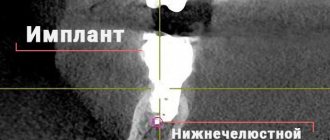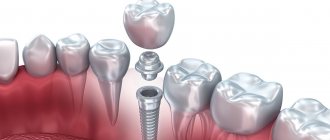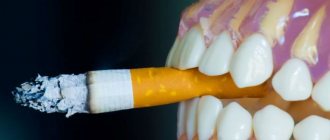With the development of implantation technology, more and more patients prefer this method of restoring lost teeth, as the most reliable, aesthetic and convenient. Set it and forget it! This is exactly what happens in most cases, unless the plans of the doctor and his patient are disrupted by the most formidable complication, due to which the implant can be lost - peri-implantitis. This is what visitors to numerous dental forums scare each other with, so much so that some give up the idea of installing an implant altogether. In this article, let's figure out what peri-implantitis is, how to avoid it, and, if necessary, treat it.
What is peri-implantitis?
Peri-implantitis is an inflammation of the tissues and bone surrounding the implant, which ultimately, without timely intensive treatment, leads to bone loss and loss of the implant.
Peri-implantitis is much easier to prevent than to stop a process that has already begun. The main cause of the disease is a bacterial infection, which can occur either at the moment of implantation, and then the symptoms of the disease appear a few days after the operation, or after some time - from several months to several years.
Classification
Based on the time of occurrence after implant installation, peri-implantitis is divided into:
Early – the occurrence of rejection of the implant system before a month after surgery (reason – non-fusion of the implant with the jaw).
Medium-term – rejection within a period of three months to two years (reason – defects in calculating the load of the system on the alveolar process).
Late – the occurrence of problems with implants for a period of more than two years (the reason is the patient’s poor oral care).
Why does peri-implantitis occur?
According to statistics, during implantation, more than 95% of implants are successfully installed and take root. 5% of failures are associated with various reasons, but in approximately 1% of cases, peri-implantitis is “to blame” for the loss of the implant, i.e. inflammation affects approximately 1 artificial tooth root out of 100. You need to understand that complications are possible with any surgical intervention. It depends on the patient's health and immune system. If the patient has disorders or may have a decrease in immunity under the influence of unfavorable external factors, this must be taken into account. That is why implantation requires preliminary thorough diagnosis by the surgeon.
Other causes of implant infection and the development of peri-implantitis can be:
- Incorrect behavior of the patient himself after implantation:
- poor hygiene,
- violation of the treating dentist’s recommendations for the care of implants,
- increased chewing load, careless attitude towards your artificial teeth, gum injuries near the implant,
- smoking,
- ignoring routine examinations to monitor the condition of the implant roots.
- Mistakes made by specialists during implantation:
- an inappropriate prosthetic technique was chosen,
- the implant is placed in the wrong place,
- the implant is installed in a hole with a larger diameter than required,
- the load on the implant was incorrectly calculated,
- a complete diagnosis was not carried out and/or the patient’s health status was incorrectly assessed before implantation,
- During the operation, asepsis was violated.
- A low-quality implant was installed. This can happen due to the fault of the dentist or at the insistence of the patient himself.
- There was a source of infection in the patient's mouth - caries, periodontal disease, dental plaque and calculus. In order for implantation to proceed without complications, all sources of possible infection in the oral cavity must be eliminated at the preparation stage.
Treatment methods
Treatment is carried out in stages. First, the inflammatory process is eliminated using therapeutic methods, then surgical sanitation is performed. At the first, conservative stage, the oral cavity is sanitized, plaque and tartar are removed. Peri-implant pockets are irrigated with special solutions. At home, the patient should rinse his mouth and make applications with medications.
Then the surgical stage begins. To access the bone and surface of the implant, an incision is made in the gum and a periodontal flap is created. Through the formed hole, the doctor removes granulation tissue, cleans the surface of the implant with a curette and rinses the pocket. The wound is sutured and covered with a bandage. During the postoperative period, it is important to exclude the development of an infectious process, therefore a course of antibiotics and rinsing the mouth with antiseptics are prescribed.
If the pathological process is started and accompanied by relapses, the only solution is to remove the implant. After this, thorough treatment is carried out, and after complete recovery, reimplantation is carried out.
Treatment of peri-implantitis is complex and takes a long time, so it is very important to choose the right clinic where implantation will be performed. Installation of implants by an experienced surgeon will minimize the risk of medical error, and subsequent implementation of all his recommendations will prevent the development of inflammation in the postoperative period.
Implantologists at the 32 Dent clinic have extensive experience in successful operations. We work with certified materials and install high-quality implants from well-known brands. Implantation in our clinic is a safe procedure.
Symptoms of peri-implantitis:
- The disease begins with redness, discomfort and swelling of the gums in the area of the installed implant.
- There is bleeding of the gums in the problem area.
- At the site of inflammation, connective tissue begins to grow.
- The gum moves away from the implant, as in periodontal diseases, and a periodontal pocket forms around the titanium rod.
- Serous fluid and pus may be released from the pocket, and a fistula may form.
- The X-ray image reveals a noticeable loss of bone tissue around the implant.
- The implant becomes loose, the patient feels its mobility, this provokes further destruction of the bone around the titanium rod.
- Ultimately, if the inflammatory process is not stopped, implant rejection occurs.
Diagnostics
Diagnosis occurs through visual inspection of the lesion site and the use of instrumental techniques. The use of these techniques is sufficient to determine the degree of the inflammatory process.
When examining the oral cavity, the doctor sees:
- hyperemia of the mucous membrane;
- the presence of swelling of the gum tissue;
- fistulas (if any).
Additional research methods:
- stomatoscopy – using fiber optics, an examination of the implanted system and surrounding tissues is carried out;
- periapical radiography – determine the level of the implant after installation;
- probing - performed with moderate pressure on the structure;
- CT scan;
- general blood analysis;
- orthopantomography;
- test with Shiler-Pisarev solution;
- bacteriological studies;
- blood biochemistry.
Peri-implantitis must be differentiated from mucositis. With this pathology, resorption of the alveolar process does not occur. There is inflammation and bleeding of the gums in the area where the implant is installed.
How is peri-implantitis treated?
The success of treatment for peri-implantitis depends on what stage of the disease it is started at: the earlier, the better the prognosis.
Treatment is aimed primarily at relieving inflammation in the area and restoring bone volume once it has begun to be lost. Therefore, there are 2 main stages in treatment - sanitation of the inflamed area and surgical bone augmentation.
- Before starting treatment, the doctor conducts a diagnosis. The main stage of such a diagnosis will be a 3D CT scan to accurately determine the affected area and the condition of the bone tissue.
- Then professional hygiene of the implant and adjacent areas is carried out - removal of soft dental deposits and tartar from the dental crown and from the subgingival space using ultrasound.
- Next, surgical sanitation of the area of inflammation is carried out - the abscesses are opened. Cleaning of periodontal pockets is carried out in the same way as for periodontal diseases - using special curettes or the Vector device. It is advisable that the problematic implant is not loaded.
- At the same time, bone grafting can be performed using the method of directed bone regeneration using bone chips and regenerating membranes.
- In parallel, the patient is given local and general antibacterial therapy and antibiotics are prescribed.
- When treating peri-implantitis, it is very important to maintain daily hygiene using antiseptic drugs.
The result of treatment is necessarily monitored by repeated x-ray diagnostics.
It must be remembered that peri-implantitis is prone to frequent relapses, therefore, after treatment, monitoring the condition of the implants and increased attention to proper hygiene are MANDATORY.
Establishing diagnosis
The success of treatment largely depends on when the patient consults a doctor. Therefore, we recommend visiting a dentist as soon as the first signs of peri-implantitis appear - swelling and bleeding of the gums. The doctor will conduct an examination and prescribe additional research to clarify the diagnosis:
- Dentistry.
- X-ray examination.
- Computed tomography.
These methods allow not only to clarify the diagnosis, but also to assess the degree of bone tissue loss. Additionally, laboratory tests may be prescribed.
Prevention of peri-implantitis
From all of the above, it follows that peri-implantitis is much easier to prevent than to treat later. In order to protect yourself as much as possible from such a complication, both immediately after implantation and during subsequent life with an implant, you must:
- Carefully monitor oral hygiene, use not only a toothbrush and toothpaste to care for teeth and implants, but also special products - a monotuft brush, a dental brush, special dental floss and an irrigator. Visit a hygienist regularly for professional oral hygiene.
- Do not violate the recommendations of your doctor immediately after the implantation procedure.
- Pay attention to your health, strengthen your immune system, and don’t smoke.
- Regularly undergo scheduled examinations with your attending physician with RG diagnostics at least once a year to monitor whether there is bone atrophy.
- Carefully choose the clinic and doctor where you get implants.
- Place implants of brands that have already proven themselves among doctors and patients - in this case, the savings turn against the patient, because If the implant fails, you will have to undergo quite expensive treatment and pay for the implantation again.
Forecast
The prognosis for peri-implantitis is often negative. This often leads to the implant not taking root. A severe, inflammatory process in the oral cavity begins. Doctors are forced to remove the implant, and the patient undergoes treatment. And only then will the implant be installed again. And no one can guarantee the patient that peri-impantitis will not develop again. This disease often recurs if the patient does not begin to follow doctors' instructions. This is an additional cost for the patient. Several relapses in a row occur if the implant was installed in violation of the technology.
Treatment of peri-implantitis under warranty
If peri-implantitis has developed due to mistakes made by the implant surgeon during the operation, all treatment services must be provided to you under a guarantee, that is, free of charge. Moreover, you will not have to pay for re-implantation, or rather, a new implant that will be placed in place of the unused structure.
To ensure that you have the opportunity to receive treatment under warranty, before the operation, always find out whether a particular clinic provides a guarantee to its patients, and carefully read the service agreement. In particular, the contract should contain a clause that states that if the implant is rejected due to medical errors, the clinic undertakes to eliminate all the consequences of this complication at its own expense.
Calculate the cost of treatment by taking a short test in 20 seconds!
Do not delay your treatment, because in this matter time plays against us.
Is it possible to cure peri-implantitis with folk remedies?
Self-medicating peri-implantitis is not only useless, it can be dangerous to your health. You must understand that such a serious inflammatory process simply cannot be eliminated by rinsing with decoctions or using other folk remedies, recipes for which are often found on the Internet.
Tablets sold in pharmacies will not help with peri-implantitis. If you suspect a dental implant failure, you should immediately contact a specialist - there are no other ways to alleviate your condition and cure peri-implantitis!
Should I remove the implant during peri-implantitis or not?
The answer to this question definitely does not need to be looked for on forums on the Internet - only a doctor will give it to you after examination, diagnosis, and a detailed study of all the features of your case. However, practice shows that it is better to remove the implant that has not taken root and carry out reimplantation after some time. Why is this the right thing to do?
The fact is that an implant that has not taken root, even after surgical treatment, can be rejected after some time. This is especially true for cases in which peri-implantitis has developed due to medical errors made during primary implantation. In this case, even surgical treatment will not correct the situation, but will simply remove the main symptoms and stop the development of peri-implantitis for some time.
If the reason for implant rejection is a medical error, then the only way to solve the problem is to remove the implant, give the tissue time to fully recover, and then carry out reimplantation.
Causes of peri-implantitis: etiology and pathogenesis
Why does it occur
A dental implant is a foreign body, and its implantation does not always go smoothly. Many reasons can affect the success of the procedure.
Medical errors (statistically rare):
- Ignoring aseptic and antiseptic requirements during surgery.
- Inadequate risk assessment, insufficient diagnosis.
- Irrational choice of implantation tactics - excessive efforts when screwing in the structure, inadequate suturing of the wound .
- Choosing a low-quality implant system - it is made of cheap materials, has a poor design, or is completely fake.
- Errors in the installation of the main and intermediate elements (gingival former, abutment) - microscopic gaps between the components increase the risk of bacterial processes.
- Installation of low quality dentures.
Technical errors at different stages of the installation of an artificial tooth subsequently lead to overload of the periodontium, the occurrence of a hematoma in the implantation zone, gum suppuration and the emergence of a number of problems.
Common reasons due to the patient's fault:
- Lack of professional oral care leads to the development of pathological microflora in the area of inflammation. Microbiological analysis reveals bacteroids and treponema.
- Adherence to bad habits - smoking has a negative effect on the tissues of the oral cavity and provokes inflammatory and purulent processes.
Opinion of an implant surgeon : “Implantation is a rational solution for restoring dental defects. At the same time, adjacent teeth are not ground down, chewing and digestion are improved. The dentures used are aesthetic and match the color scheme of natural teeth. The complication of peri-implantitis occurs extremely rarely. The procedure is not recommended for patients who have undergone treatment for osteoporosis with bisphosphonate drugs.”
Who is at risk
- Chronic smokers;
- patients with diabetes mellitus;
- patients with reduced immunity;
- periodontal diseases;
- those suffering from bruxism (teeth grinding).
Stages and symptoms of the disease
Stages of peri-implantitis:
- thinning of bone tissue, formation of pockets between the gum and abutment. The mobility of the structure, redness and bleeding of surrounding tissues increases.
- loss of implant stability, enlargement of gum pockets, bone deformation.
- constant mobility of the dental implant, disruption of soft tissue along the vertical root line.
- bone destruction, the structure is visible through the gum tissue.
Symptoms of the development of peri-implantitis:
- pain when biting, touching with tongue, brushing teeth.
- bleeding gums.
- redness or bluish discoloration of the gum tissue, increasing swelling.
- mobility of the dental implant structure.
- the appearance of gum pockets (gum separation from the implant structure or gum former)
- suppuration (with advanced peri-implantitis)










